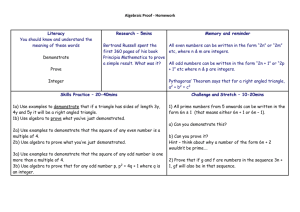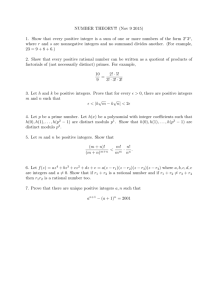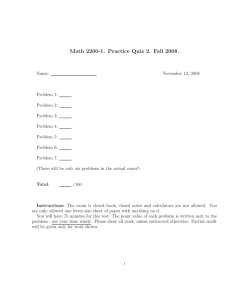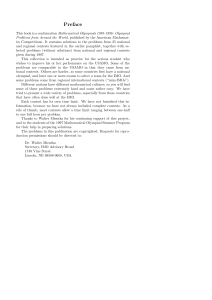AMM problems November 2013, due before 31 March 2014 TCDmath problem group
advertisement
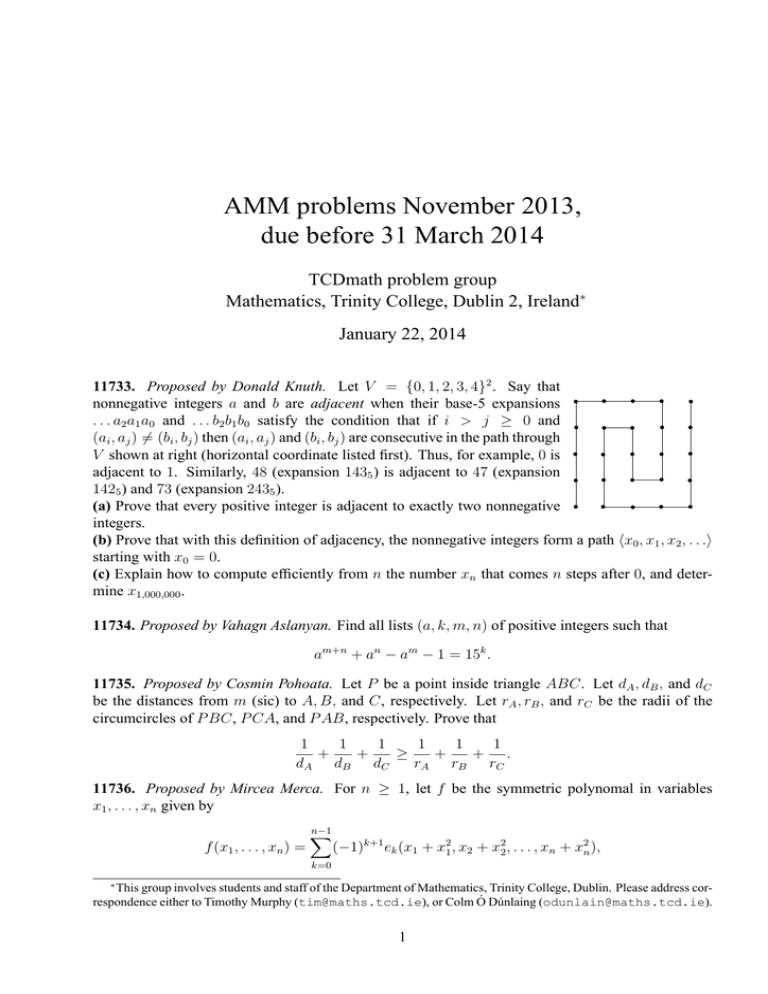
AMM problems November 2013,
due before 31 March 2014
TCDmath problem group
Mathematics, Trinity College, Dublin 2, Ireland∗
January 22, 2014
11733. Proposed by Donald Knuth. Let V = {0, 1, 2, 3, 4}2 . Say that
nonnegative integers a and b are adjacent when their base-5 expansions
. . . a2 a1 a0 and . . . b2 b1 b0 satisfy the condition that if i > j ≥ 0 and
(ai , aj ) 6= (bi , bj ) then (ai , aj ) and (bi , bj ) are consecutive in the path through
V shown at right (horizontal coordinate listed first). Thus, for example, 0 is
adjacent to 1. Similarly, 48 (expansion 1435 ) is adjacent to 47 (expansion
1425 ) and 73 (expansion 2435 ).
(a) Prove that every positive integer is adjacent to exactly two nonnegative
integers.
(b) Prove that with this definition of adjacency, the nonnegative integers form a path hx0 , x1 , x2 , . . .i
starting with x0 = 0.
(c) Explain how to compute efficiently from n the number xn that comes n steps after 0, and determine x1,000,000 .
11734. Proposed by Vahagn Aslanyan. Find all lists (a, k, m, n) of positive integers such that
am+n + an − am − 1 = 15k .
11735. Proposed by Cosmin Pohoata. Let P be a point inside triangle ABC. Let dA , dB , and dC
be the distances from m (sic) to A, B, and C, respectively. Let rA , rB , and rC be the radii of the
circumcircles of P BC, P CA, and P AB, respectively. Prove that
1
1
1
1
1
1
+
+
≥
+
+ .
dA dB dC
rA rB rC
11736. Proposed by Mircea Merca. For n ≥ 1, let f be the symmetric polynomal in variables
x1 , . . . , xn given by
n−1
X
f (x1 , . . . , xn ) =
(−1)k+1 ek (x1 + x21 , x2 + x22 , . . . , xn + x2n ),
k=0
∗
This group involves students and staff of the Department of Mathematics, Trinity College, Dublin. Please address correspondence either to Timothy Murphy (tim@maths.tcd.ie), or Colm Ó Dúnlaing (odunlain@maths.tcd.ie).
1
where ek is the kth elementary polynomials in n variables. (For example, when n = 6, e2 has 15
terms, each a product of two distinct variables.) Also, let ξ be a primitive nth root of unity. Prove that
f (1, ξ, ξ 2 , . . . , ξ n−1 ) = Ln − L0 ,
where Lk is the k-th Lucas number (that is, L0 = 2, L1 = 1, and Lk = Lk−1 + Lk−2 for k ≥ 2).
11737. Proposed by Nguyen Thanh Binh. Given an acute triangle ABC, let O be its circumcenter,
let M be the intersection of lines AO and BC, and let D be the other intersection of AO with the
circumcircle of ABC. Let E be that point on AD such that M is the midpoint of ED. Let F be the
point at which the perpendicular to AD at M meets AC. Prove that EF is perpendicular to AB.
11738. Proposed by Stefano Siboni. Three point particles are constrained to move without friction
along a unit circle. Three ideal massless springs of stiffness k1 , k2 , and k3 connect the particles
pairwise. Show that an equilibrium in which the particles occupy three distinct positions exists if
and only if 1/k1 , 1/k2 , and 1/k3 can be the lengths of the sides of a triangle. Show also that if this
happens, the equilibrium length L of the spring with stiffness k1 is given by
s
2
p
1
1
1
L = k2 k3
− 2.
+
k2 k3
k1
11739. Proposed by Fred Adams, Anthony Bloch, and Jeffrey Lagarias. Let B(x) =
Consider the infinite matrix product
M (t) = B(2−t )B(3−t )B(5−t ) . . . =
Y
B(p−t ),
p
where the product runs over all primes, taken in increasing order. Evaluate M (2).
2
1 x
x 1
.




